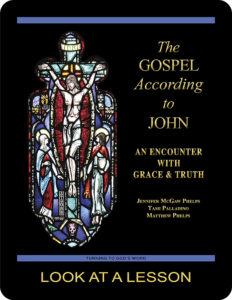Lord
 The fourth chapter of the Gospel According to John (NABRE) highlights one of many instances in which different people use the same title to refer to Jesus, though this fact has been lost in most translations. Whenever someone uses the title Lord or sir to refer to Jesus, they’re using the same Greek word, κύριος (kyrios).
The fourth chapter of the Gospel According to John (NABRE) highlights one of many instances in which different people use the same title to refer to Jesus, though this fact has been lost in most translations. Whenever someone uses the title Lord or sir to refer to Jesus, they’re using the same Greek word, κύριος (kyrios).
Kyrios has a number of different meanings. At its root, it refers to one who has power over you. In the modern world, public officials such as police officers and judges would fall into this category, along with bosses. As a direct address and greeting, kyrios was used as a sign of politeness and respect much as we use the word sir.
In the Gospel According to John, we see kyrios in two main contexts. First, kyrios is the word used to refer to God or the Lord. The second usage occurs when people refer to Jesus, which typically takes two different translations. In many cases these references are translated as “sir.” We see examples of this usage in the Gospel According to John 4:11; 4:49; and 5:7 (all three links are to the NABRE), and many other places. In some other cases, however, the same word also being used to refer to Jesus is translated as Lord or as Master. Examples can be found at the Gospel According to John 11:27 and 13:6 (both links are to the NABRE).
The different translations of how people address Jesus raise an important question. Often when the person addressing Jesus is a woman or a Gentile, the translation is “sir,” whereas when it’s one of the apostles or a Jew, the translation is Lord. In both cases, the linguistic structure is the same. The point the translators seem to be making is that Jesus can be considered superior to women and Gentiles by virtue of being a normal Jew. For Jesus to be considered superior to a Jewish man, that man must refer to Jesus by using the same title he would use to refer to God.
This disparity in translation is perhaps not fair, as in every occurrence of “sir” or Lord in the Fourth Gospel the underlying word is the same. It’s a useful exercise whenever you encounter either word—sir or Lord—in the Gospel According to John to remember that the Greek concept is the same for both.
you also may like our study of the Gospel According to John
 The Gospel According to John: An Encounter with Grace & Truth, a 25-lesson Catholic Bible study with an imprimatur, examines the Fourth Gospel’s view of Jesus Christ as the Son of God, with special emphasis on the institution of the sacraments of the Church as the means by which Christians are purified and made holy. This recently revised study includes maps and additional commentary, and takes a closer look at the way in which Jesus relates to individual men and women. Click on the book’s cover to view a sample lesson.
The Gospel According to John: An Encounter with Grace & Truth, a 25-lesson Catholic Bible study with an imprimatur, examines the Fourth Gospel’s view of Jesus Christ as the Son of God, with special emphasis on the institution of the sacraments of the Church as the means by which Christians are purified and made holy. This recently revised study includes maps and additional commentary, and takes a closer look at the way in which Jesus relates to individual men and women. Click on the book’s cover to view a sample lesson.
 Click on the picture of the statue of Moses with horns (above) to learn more about Lost in Translation. A new entry is archived each Monday. Contact us to receive Lost in Translation by email every week. You may use any of the contact links on our website to ask Matthew a question.
Click on the picture of the statue of Moses with horns (above) to learn more about Lost in Translation. A new entry is archived each Monday. Contact us to receive Lost in Translation by email every week. You may use any of the contact links on our website to ask Matthew a question.
